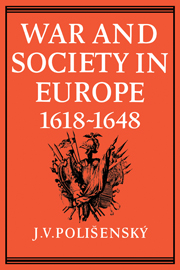Book contents
- Frontmatter
- Contents
- Preface
- Map of Czechoslovakia with list of locations of archives and libraries
- Introduction
- PART ONE PROBLEMS IN THE HISTORY OF THE THIRTY YEARS' WAR
- PART TWO THE EFFECTS OF THE THIRTY YEARS' WAR
- 8 The aftermath of conflict
- 9 Changes in the composition of the Bohemian nobility
- Conclusion
- Notes
- Appendix Tabular survey of archives, libraries and individual collections
- Index
8 - The aftermath of conflict
Published online by Cambridge University Press: 05 April 2012
- Frontmatter
- Contents
- Preface
- Map of Czechoslovakia with list of locations of archives and libraries
- Introduction
- PART ONE PROBLEMS IN THE HISTORY OF THE THIRTY YEARS' WAR
- PART TWO THE EFFECTS OF THE THIRTY YEARS' WAR
- 8 The aftermath of conflict
- 9 Changes in the composition of the Bohemian nobility
- Conclusion
- Notes
- Appendix Tabular survey of archives, libraries and individual collections
- Index
Summary
The general exhaustion of all the participants in the conflict made the compromises and partial peace treaties of 1648 a necessity. But two parts of the European conflict – those between France and Spain and between Sweden and Poland – were not resolved at this time: they prolonged the general political crisis until 1660. With the Turkish danger still looming on the horizon, the Habsburgs had to reconcile themselves to the impracticability of their far-reaching plans.
The programme of feudal and Catholic restoration could therefore be forced through only in certain regions – those very regions in which the conflict had started, the Bohemian lands and (partially, at least) Upper Hungary. For these regions, and for most of Germany as well, the Thirty Years' War meant retrogression. In the west and north of Europe – although even there the suffering caused by the war was immense – the social changes which were speeded up by the conflict left the way open for unprecedented progress.
It is not easy to state just what the Thirty Years' War did mean to Europe as a whole, or even to its different parts.
Generalizations about this ‘pre-statistical’ age are always risky. The case of Bohemia and Moravia shows that any methods of investigation that are adequate must also be complicated; even so they provide us with information that is of uneven value at best.
- Type
- Chapter
- Information
- War and Society in Europe 1618–1648 , pp. 199 - 201Publisher: Cambridge University PressPrint publication year: 1978



